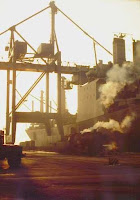
Tuesday, June 17, 2008
Monday, June 2, 2008
Signals
 The new signal cantilevers being installed. This is just RR East of Carkeek Park.
The new signal cantilevers being installed. This is just RR East of Carkeek Park. Looking RR West from the beach at Carkeek Park, we see the new "Control Point Blue Ridge," with the North Beach neighborhood behind it,. The pair of new crossovers, with high-rail removal point between them, are between the two visible new cantilever signal towers. The North Beach community beach access crossing through the middle of the control point via a new set of steel stairs down from the bluff and a set of wood stairs down to the beach. The Blue Ridge neighborhood and Blue Ridge community beach access are both out of the picture to the left.
Looking RR West from the beach at Carkeek Park, we see the new "Control Point Blue Ridge," with the North Beach neighborhood behind it,. The pair of new crossovers, with high-rail removal point between them, are between the two visible new cantilever signal towers. The North Beach community beach access crossing through the middle of the control point via a new set of steel stairs down from the bluff and a set of wood stairs down to the beach. The Blue Ridge neighborhood and Blue Ridge community beach access are both out of the picture to the left. Looking further RR East from Carkeek we see a pair of the classic signals such as have characterized this stretch for many years. I think I will enjoy the more dramatic appearance of the new cantilevers more than I will miss the older signals.
Looking further RR East from Carkeek we see a pair of the classic signals such as have characterized this stretch for many years. I think I will enjoy the more dramatic appearance of the new cantilevers more than I will miss the older signals.[Note that due to constraints of time & laziness, these images were made by telephoto with resulting comprimise of image quality.]
Richmond Beach - 5/23/08
 Not quite my first train picture with my new camera, but only because it is the second picture I took of this train.
Not quite my first train picture with my new camera, but only because it is the second picture I took of this train.Non-railroad pictures at foograf.
 My earliest "serious" camera was a circa 1930 folding Zeiss Ikon 6x4.5cm of my dad's. Taking a picture was an interesting process:
My earliest "serious" camera was a circa 1930 folding Zeiss Ikon 6x4.5cm of my dad's. Taking a picture was an interesting process:- Open the hatch on the front of the camera
- Extend the lens on its leather bellows
- Set the aperature (f-stop) on the lens
- Set the shutter speed (fraction of a second) on the lens
- Set the focus on the lens
- Cock the lens
- Frame the shot
- Release the shutter
- Open a little shutter covering a pair of small red windows on the back of the camera
- Turn a knob on the top of the camera to either move the frame number to the next window or move the next frame number to the first window
- Close the back shutter to reduce the risk of light leak fogging the film
- Recock for next picture, having made necessary adjustments to any settings
- Or, collapse bellows and close hatch and put camera back in pocket
 Over the years that followed, the succession of cameras generally sought to automate at least some of those tasks while not compromising too much on image quality or size of camera.
Over the years that followed, the succession of cameras generally sought to automate at least some of those tasks while not compromising too much on image quality or size of camera.Sometimes I was happy to just have a compact convenient camera. Other times I wanted to be able to reach out with telephoto or spread my grasp for wide angle.
The GN U-25B set in Edmonds, above right, was taken about 1966 with the Zeiss. The German BR 50 in Bremerhaven, at left, was circa 1971 with a Pentax Spotmatic.
Subscribe to:
Posts (Atom)

